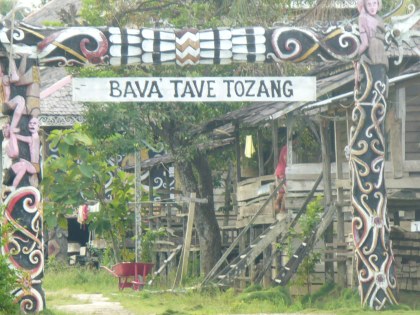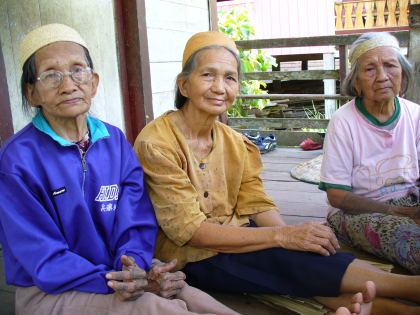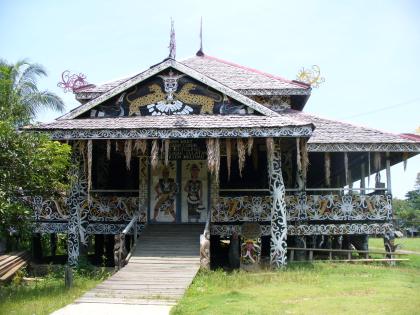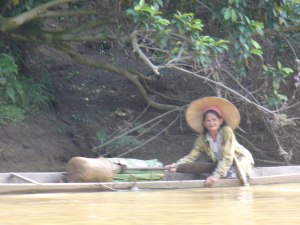1 October 2007
“We are proud of Setulang forest. But we are also sad because people have to go far from the village to earn more income. We hope (you) can help us improve our economic live so that they don’t have to go abroad only for paying expenses for children school.” (Bisin, Setulang elder)
GEOGRAPHIC AND DEMOGRAPHIC SITUATIONS
Setulang is located in the sub-district of South Malinau, the district of Malinau. From Jakarta, it takes up to 2 hours by plane to Balikpapan, East Kalimantan, then another 1 hour by plane from Balikpapan to Tarakan, a small island on the eastern part of East Kalimantan. Later, another mode of transport will be taken, by a speed boat, from Tarakan. The travel time is about 3 hours to cruise the river and seaside and finally reach the town of Malinau. From the town, we have to go to Pulau Sapi, a small kampong, for about 45 minutes on road. From the kampong, Setulang can be reached by ketinting (small boat with machine). It takes up to 45 minutes. Other means of transport, by vehicles, might be taken. However, it takes more time and sometimes if the road is covered by mud after rains, it will be hard to travel on it.
There are about 260 households in the village. According to the customary chief, Laing, the population number is about 800 persons. If it is added by some community members who stay out of the village (for the reasons of works, schooling, etc), the total number can reach up to 1,000 persons. The community of Setulang is classified as Oma’ Lung, a sub-ethnic group of Dayak Kenyah.
THE HISTORY OF COMMUNITY MIGRATION TO SETULANG VILLAGE
Originally, Oma’ Lung people were from Long Sa’an village. When they lived in Long Sa’an, due to the remoteness, it was difficult to the community members reached local markets to buy basic needs such as salt, kerosene and cloth. The first two things were very important to them. Salt was used to cook. Sometimes when they ate, they just garnished rice with salt. Kerosene was used to fuel traditional lamps functioning as light during the night.
When living in Long Sa’an, if they wanted to buy goods, they had to go to the nearest market in Tanjung Selor and take a long difficult journey. By cruising the river with dangerous streams, sometimes it took up to one month for a return trip only for purchasing goods.
It was also difficult for the community to get access to education and health services. “Because the village was too remote, we could not get any government services. Children were only able to get education up to primary level. It was also very difficult to access markets to sell our farming products or buy basic needs“, Jalung, a 67-year-old man, said.
Group by group over several years, the community started to move from Long Sa’an to new places. The first wave of the migration was done many years ago, before the 1960s, to Long Uli village. In 1968, the community of Long Sa’an started to move to Setulang village. The migration was conducted phase per phase for several years. The last migration to Setulang was carried out in 1978. For additional information, apart to Long Uli and Setulang, the community of Long Sa’an also moved to other villages namely Long Pujungan, Long Balua, Pimping, Tanjung Selor and Batu Kajang.
LIVELIHOOD AND TYPES OF WORK
Mostly, people in Setulang do ladang farming (agricultural conversion land, usually for paddy). The activity to plant paddy usually starts in August. They harvest it usually from January to March. The community also cultivates horticultural plants such as corn, sweat potato and cassava. Sometimes, they also do fishing in River Setulang and hunting (mainly wild boars) around Tane Olen Forest. All of these are conducted for daily consumption only.
Agroforestry practices seem not to be conducted yet by the community. They still take fruit of wildly-grown-trees from the forest. However, a member of community, Philipus, has started to cultivate his land for agroforestry purpose. He has planted tens of cempedak trees (a kind of jackfruit, with stronger smell and sweeter taste). The trees have started to produce fruits –ready to sell–.
Several persons work in logging companies, mostly in Brazil and a few in Sarawak, Malaysia. Usually, they can make money more than usual farmers in the village. They can have better housing. However, such work is not a famous choice for the community. They prefer to be at the village and do cultivation.
Although income is mostly enough for basic life only, the community have strong willing to send their children to school. To reach the level of senior high school or above, they usually save money from paddy selling, if the ladang can produce more rice in the year. If the harvest is not good or successful, they cannot sell the rice. It will be only kept for their own consumption for the whole year.
Another way of the community to get more money to pay school expenses is by making and selling handcraft products such as mats (small and big), hats and anjat (a kind of big backpack with open-rounded-shape on the top). All of these are made of certain grass, a type of palm plants or rattan. Mostly, the activity is conducted by women. The products are still limited and the quality should be up-graded.
FOREST: THE IMPORTANCE AND MEANING FOR THE COMMUNITY
A tradition to manage and take care of forest has been maintained by the community for long time. When living in Long Sa’an, they had their own forests. The sub-ethnic group of Oma Lung had 2 types of forests when they were in the old village: Tane Olen for paren (for the haves only) and Tane Olen accessible for the The whole community. While they moved and set up the Setulang village, the tradition maintained.
Setulang forest has many functions: for water protection, adat/customary and site for hunting and food gathering. The tradition of forest taking care of Setulang people has been an inspiration for many people.




Nice writing style. Looking forward to reading more from you.
Chris Moran
Comment by Chris Moran — October 18, 2008 @ 12:11 pm
It’s a very beautiful place and beautiful people. I wish I can meet with this Oma’ Lung people someday. Keep it up so that we can continue looking on your blog.
Comment by Moris Icang — November 7, 2009 @ 7:15 pm